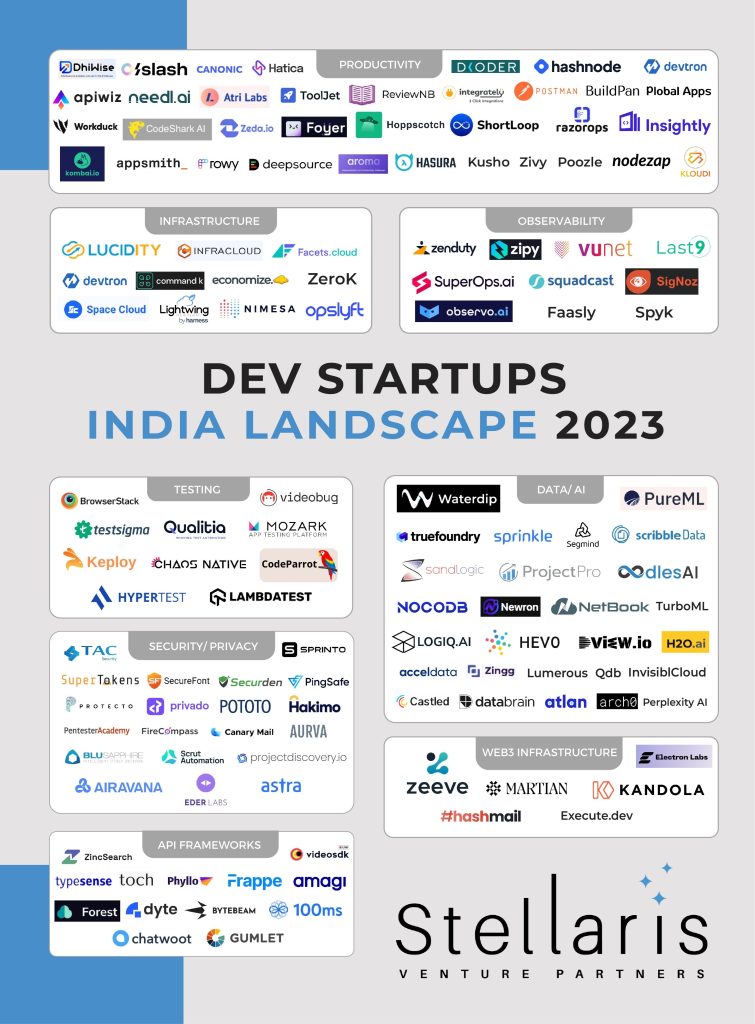A lot has changed since we started mapping India’s Dev/ Infra startup landscape last year. We’ve seen economic stagnation in some of the largest software markets, a significant upheaval in tech hiring, and a major shift in tech expenditure. Even in these uncertain times, Dev/Infra companies have a market cap of $150B+ (a growth of 13% YoY). We, therefore, decided to renew this exercise and take a closer look at the trends contributing to this growth.
Shortened development cycles increased the demand for productivity tools
Reports suggest productivity tools will claim 11% of software expenditure budgets globally. Over the last year, we continued to see the proliferation of productivity tools for different engineering functions – developers, product managers, designers and devops engineers. It included a wide range of tools that can help with programming, collaboration, project management, testing, deployment and monitoring. Some recurring areas included:
- Collaboration and knowledge sharing: With the advent of remote work, we’ve seen a new set of tools emerge to help developers, product managers and designers to share knowledge and work together more efficiently. This category of companies saw the most activity of early stage funding with 5 investments.
- Observability: Observability tools are becoming increasingly common for developers as they strive to build and maintain complex, distributed systems. Some tools provided developers with better insights into their observability data, some unlocked potential adjacent use cases – creating test cases, monitoring for security vulnerabilities while others provided better alert management solutions.
- Security: We also observed an expansion of solutions targeted towards privacy engineering and data protection and saw 2 companies raising funds.
Tooling increased the adoption of API-first development practices
API management and tooling, in the last few years, has gained significant importance with the rise of microservices and cloud-native architectures. Over the last year, we have witnessed the emergence of various API management platforms that provided solutions around API security, debugging, performance, analytics, and documentation. We believe that API as a product stands at $10B (15% YoY growth) and the API testing market size is expected to grow significantly in the coming years, driven by the increasing adoption of APIs in software development and the growing need to ensure quality and reliability of API-based applications.
MLOps companies see continued growth
The number of MLOps companies from India in 2022 continued to grow rapidly; we met 12 companies last year. With companies increasingly realising the importance of AI/ML models in their workstreams, their inclination to invest in tools and platforms has improved. Some key trends in the MLOps space included the rise of collaboration platforms for data scientists and ML engineers, new-age deployment solutions for ML models, the growing trend of ML applications on edge devices, the emergence of new tools around the modern data stack, and the increasing use of model monitoring tools to ensure performance.
In 2022 alone, we met over 100 Dev/Infra startups from India gaining significant traction from all over the world. We also saw 14 such early-stage startups raising $17M+ in cumulative funding so far. Here’s an updated landscape to give you an overview of how the ecosystem is booming.

In 2023, we foresee 3 key trends driving the Dev/Infra ecosystem
- LLM applications for Dev Tasks will become popular
We believe that LLM applications for Dev tasks will become popular in the coming year. Within the first quarter of the year, we’ve seen multiple companies emerge in the space of code generation, debugging, knowledge sharing and no-code data science. As LLMs continue to improve in their ability and accept multimodal input, we would see greater use cases where developers are augmented using Gen-AI.
- LLMOps will power next generation of AI
With Gen-AI and other Large Models finding wide scale applications across every aspect, integrating AI and LLMs into a product roadmap will require significant effort on infrastructure. Most companies will struggle taking applications to production with the currently available tooling. We believe there will be opportunities to create companies around fine-tuning, versioning and deploying LLMs. Additionally, there could be opportunities around monitoring of fine-tuned models, frameworks for prompt engineering and streamlining of different workflows around LLM applications.
- More Dev-focused companies will go Open Source
The growing trend of dev-focused companies from India with the OSS strategy has been an interesting development. We have seen companies with a primary focus on building community around their technology. We believe that this can lead to increased adoption, feedback, and contributions from other developers, which can ultimately improve the quality and functionality of the software. Once these companies gain a critical mass of developers, companies can monetize via paid support and services to help users implement and maintain the software or offer additional features or functionality through add-ons or plugins that are sold for a fee.
We believe 2023 is going to be yet another exciting year for the Dev/Infra startup and the venture ecosystem. If you’re a founder, investor, operator, or enthusiast in this space, please write to us at sayantan@stellarisvp.com and we would love to talk.
A tabular version of the landscape is available at this link. We continue to closely track the evolving ecosystem, and will be updating this list every quarter.

